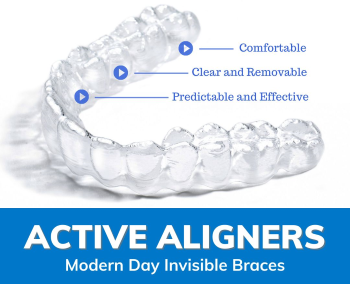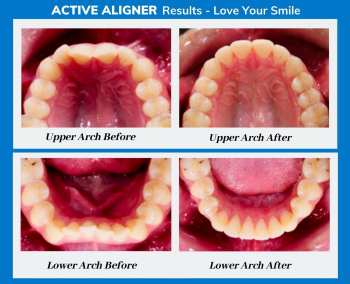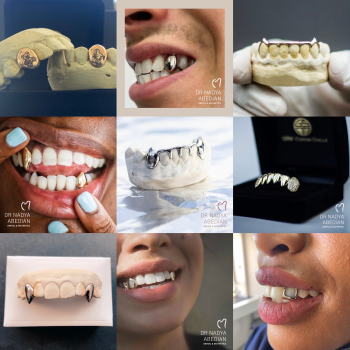| |
 |
 |
| WHITENING
One of the most popular ways to enhance your smile, dental bleaching, also known as tooth whitening, is a common procedure in general dentistry but most especially in the field of cosmetic dentistry.
As a person ages the adult teeth often become darker due to changes in the mineral structure of the tooth, as the enamel becomes less porous. Teeth can also become stained by bacterial pigments, foodstuffs and tobacco. Certain antibiotic medications can also cause teeth stains.
The effects of whitening can last up to three years. However, this will vary from person to person. The effect is less likely to last as long if you smoke, or eat or drink products that can stain your teeth. Ask your dentist for their opinion before you start the treatment.
|
 |
| |
 |
| GUM DISEASE
Periodontal disease, commonly known as gum disease, is (along with tooth decay) the most prevalent human disease - and one of the most under treated.
Many people have some form of gum disease. The disease is usually painless at the outset, but if undetected and untreated, the bone that supports the teeth in the jaw bone becomes gradually destroyed, causing the teeth to become loose or painful.
Usually, gum disease is caused by a buildup of plaque. Plaque contains bacteria, which produce toxins that irritate and damage the gums.
Gum disease can cause bad breath and change the appearance of your smile.
Recent research has found a relationship between gum disease and more serious health problems such as cardiovascular disease, diabetes and respiratory related diseases. Therefore, good periodontal health is a key component of a healthy body.
Persons with periodontitis must realise that a lifelong regimen of excellent hygiene and professional maintenance care with a dentist/hygienist or periodontist is required to maintain affected teeth. Dental check-ups serve to monitor the person's oral hygiene methods and levels of attachment around teeth, identify any early signs of periodontitis, and monitor response to treatment.
Periodontists specialise in treating this diseaseswith the most effective, modern and painless methods that have been scientifically proven.
|
 |
| |
 |
| CROWNS
A dental crown (otherwise known as a cap) is a type of tooth-shaped cover which completely caps or encircles a tooth or dental implant.
Crowns may be placed for several reasons. Usually the tooth has been broken or damaged a great deal by decay and they are often needed when a large cavity threatens the ongoing health of a tooth.
As a result, a filling can't replace enough of the tooth or make the tooth strong enough. It also can be used to hold a bridge in place. Crowns can be used to improve appearance as well, and may be placed to cover misshapen or badly discoloured teeth, improving the strength and appearance of the teeth.
They are typically bonded to the tooth using a dental cement and can be made from many materials; metal, ceramic, or porcelain to restore strength and eliminate discomfort. In addition, dental crowns may be used to anchor a dental bridge or to cap a dental implant post.
The dental crowns procedure is typically completed during two dentist appointments. At the first appointment, the teeth are prepped for placement of the crown; during the second appointment, the permanent crown in placed.
|
 |
| |
 |
| BRIDGES
A bridge, also known as a fixed partial denture is used to replace a missing tooth by joining permanently to adjacent teeth or dental implants using material such as composite resin or porcelain. It is, essentially two or more dental crowns joined together to form one unit.
There are different types of bridges, depending on how they are fabricated and the way they anchor to the adjacent teeth. If anchor teeth are well looked after, you can expect a good quality restoration for many years to come.
A bridge is fabricated by reducing the teeth on either side of the missing tooth or teeth by a preparation pattern determined by the location of the teeth and by the material from which the bridge is fabricated.
The amount and type of reduction done to the abutment teeth varies slightly with the different materials used.
The recipient of such a bridge must be careful to clean well under this prosthesis.
|
 |
| |
 |
| ROOT CANAL
Dental root canal treatment is something many people fear, but the plain fact is, good local anaesthesia techniques allow for effective, pain-free root canal treatment.
There have been great innovations in the art and science of root canal therapy. Dentists now must be educated on the current concepts in order to optimally perform a root canal. Root canal therapy has become more automated and can be performed faster, thanks to advances in automated mechanical instrumentation of teeth and more advanced root canal filling methods.
Additionally, if your dentist has years of experience and is sympathetic to your needs you have no need to worry. To explain further: a root canal is a naturally occurring cavity in the root of a tooth, and contains pulp tissue. This pulp tissue consists of lymph vessels, veins, arteries and nerve fibres. Endodontic therapy involves the removal of these structures, the subsequent cleaning, shaping, and decontamination of the hollows with tiny files and irrigating solutions, and the obturation (filling) of the decontaminated canals with an inert filling.
If the pulp tissue decays and becomes infected, the body's immune system will respond. The resulting swelling puts pressure on the pulp tissue. A person with an infected root canal will almost certainly feel pain, and their teeth will be sensitive as a result. An infected root canal can also result in far more serious health problems such as heart disease. If you suspect you may have an infected root canal you should see your dentist as soon as possible as dental root canal treatment is essential.
|
 |
| |
 |
| DENTAL IMPLANTS
A dental implant is an artificial tooth used to support a number of dental prostheses, including crowns, implant-supported bridges or dentures.
While high-tech in nature, dental implants can actually be more tooth-saving than traditional bridgework as implants do not rely on neighbouring teeth for support.
Implants can also support a bridge and eliminate the need for a removable partial denture. They can also provide support for a denture and make it more secure and comfortable.
Dental implants are an ideal option for people in good general oral health who have lost a tooth or teeth due to gum disease, an injury, or some other reason.
Dental implants are teeth that can look and feel just like your own. With diligent patient maintenance, implants can last a lifetime.
|
 |
| |
 |
| BOTULINUM TOXIN A
Botulinum toxin is a neurotoxic protein produced by the bacterium Clostridium botulinum and is used for cosmetic treatment of wrinkles and a range of medical procedures. The substance targets the nervous system, disrupting the nerve signalling processes that stimulate muscle contraction causing temporary muscle paralysis. This in turn reduces the appearance of existing wrinkles and prevents the formation of deep wrinkles with consistent treatments. Botulinum toxin is effective on dynamic wrinkles (wrinkles that form due to muscle movement). Commonly treated areas include the forehead, the frown lines, bunny lines on the nose, Crow’s feet around the eyes, gummy smile, downturned nose tip and masseter muscle for bruxism (grinding).
|
 |
| |
 |
| DERMAL FILLERS
Dermal fillers (commonly known as fillers) usually consist of hyaluronic acid, a naturally occurring substance in the human body. As it is naturally occurring, it is metabolized by the body therefore lasting between 6-18months depending on patient factors, type of injectable used and area. It is injected into various areas of the face to increase volume in the tissues. Commonly treated areas include the lips, the tear troughs, the nasolabial folds, the temple, the chin, the cheeks and the jawline.
|
 |
| |
 |
| ACTIVE ALIGNERS
Prescribed by a dental professional, Active Aligners are specifically designed to align teeth in a predictable, comfortable and discreet manner. Instead of metal brackets, wires or screws, a series of transparent thermoplastic ‘aligners’ are worn in stages to achieve the desired results. Active Aligners are frequently prescribed to correct varying cases of misaligned teeth, gaps between teeth and rotated teeth.
Clear aligners work on basic orthodontic principles. They are used for the correction of crooked teeth, gaps or rotation, while achieving the desired results in an organized and planned fashion. These customized trays are “invisible” and move the tooth in the desired direction. This is achieved through wearing a series of Active Aligners, each for 22 hours a day, 1 to 2 weeks at a time (one stage), which move the teeth per stage until their optimal alignment has been reached. Simple cases can be corrected in as little at 6 months.
 
|
 |
| |
 |
| CUSTOM GRILLZ
Grillz are removable metal dental ‘jewellery’ worn as a fashion statement. Grillz can be made of silver, gold or rose gold and can be inlaid with precious stones.
There are an infinite number of designs to fit all styles and budgets and designs can include anything from 1 to all the teeth.
All that is required is a simple impression and your choice of design is made to a custom fit! All done in a matter of two weeks!

|
 |
| |
|